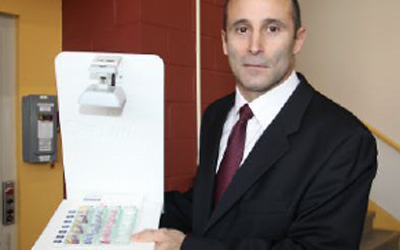
John Whitehead, president of Care Link Advantage, with medication monitoring stand, one of several devices caregivers can use to check up on seniors.
Technology solution helps seniors remain at home
March 25, 2013
Technology solution helps seniors remain at home.
CareLink Advantage’s solutions include sensors, door contacts, cameras and emergency communication device.
By: Norm Tollinsky
The Northern Ontario Medical Journal
An independent living solution developed by Sudbury-based Care Link Advantage has been embraced by New Brunswick’s Department of Social Development to help keep seniors with dementia and chronic diseases in their own homes.
The province of Alberta is also evaluating the solution and a study is being carried out by Cambrian College in Sudbury in the hope of persuading Ontario’s Ministry of Health and Long-Term Care to fund the technology.
The Care Link solution consists of a suite of sensors, door contacts, cameras and medical emergency communication devices that transmit rule-based alerts to caregivers and provide remote access to live video from the homes of their family members.
Seniors who were on a wait list for long term care turned down beds when they became available during the pilot in New Brunswick, said Care Link Advantage president John Whitehead.
When the consultant, Barbara Burnett, executive director of the Atlantic Institute on Aging, “put the report together and the government looked at it, it was a no-brainer,” he said.
The solution makes a lot of sense “when you consider the shortage of long term care beds and assisted living facilities, and the number of alternate level of care patients taking up acute care hospital beds,” said Whitehead.
New Brunswick fully funds the cost of renting the equipment, while seniors and their families are responsible for picking up the cost of Internet connectivity, noted Burnett.
The cost varies depending on the number of devices, but generally comes in at around $175 or $180 a month, a pittance compared to the cost of long term care, the cost of keeping an alternate level of care patient in an acute care hospital bed or the cost of hiring a personal support worker every night.
“The use of the system did in fact prevent admission to a nursinghome,” said Burnett. “People were able to stay at home rather than be placed in residential care and families were much more comfortable having their loved ones remain in their homes, so the province included the Care Link Advantage solution in their menuof services.”
Care plan
Caseworkers can requisition it for their clients as part of a care plan just as they would requisition “meals-on-wheels or someone to come in and do your laundry,” said Burnett.
The system includes a control panel that plugs into a telephone jack and communicates wirelessly with a “Help, I’ve fallen” pendant.
There is also a suite of sensors that record when an individual is in or out of bed, and door contacts that alert a caregiver if a loved one with dementia opens an outside door during a user-defined period of time.
Motion sensors strategically placed in the home or apartment record the individual’s movements and a medication compliance unit calls, emails or texts a caregiver if the senior hasn’t taken his or her medication at the prescribed time.
A video clip is transmitted to the caregiver when the client lifts the blister pack from the medication compliance stand, allowing the caregiver to ensure that the correct medication was taken.
Similarly, if a senior with dementia opens the front door of his apartment at 3 am, the caregiver receives an email with a video clip of the client that can then be sent to law enforcement authorities for identification purposes.
Caregivers are also alerted if a senior falls and can’t get up during the day, or is absent from bed for longer than a defined period of time at night.
“Say mom gets up at 7 a.m. and goes to bed at 11 p.m.,” said Whitehead. “During this time, motion sensors would record her walking between the bathroom, kitchen and living room. If there is no movement detected by any of the motion sensors for a given period of time, that would concern us.”
Cameras
Following the receipt of an alert, the caregiver could remotely access one or more of the cameras in the home from a computer, tablet or smartphone and check to make sure everything is OK.
At night, “if dad got out of bed to go to the washroom and hasn’t returned after 40 minutes, you’d get an alert and check up on him,” said Whitehead.
Alerts can be sent to multiple caregivers, including family members living halfway across the country, allowing families to share the burden of caring for their elders.
A password-protected portal provides access to the cameras as well as a complete log of sensor events, and allows caregivers to setor adjust rules and determine how and to whom alerts are sent.
The applied research project through Cambrian College is studying the impact of the Care Link Advantage solution by selecting 20 seniors with dementia, half of whom will have the Care Link solution.
The study is being overseen by Cambrian’s applied research developer Dr. Lisa Allen and involves several faculty members and nursing students.
“Interviews will be conducted with the seniors and their caregivers and data will be collected to track calls to 911, emergency room visits, hospital admissions and caregiver burnout,” said Allen.
www.carelinkadvantage.ca
